
a web page by Don Roberson |
GREBES Podicipedidae |
||
|
||
 |
||
Grebes spend virtually all their time in the water and are very ungainly on land, even when just turning eggs at an anchored nest of floating vegetation. This pair of Least Grebe (below, an evocative photo by Grey W. Lasley) was taken at an intimate moment on their floating nest.
|
||
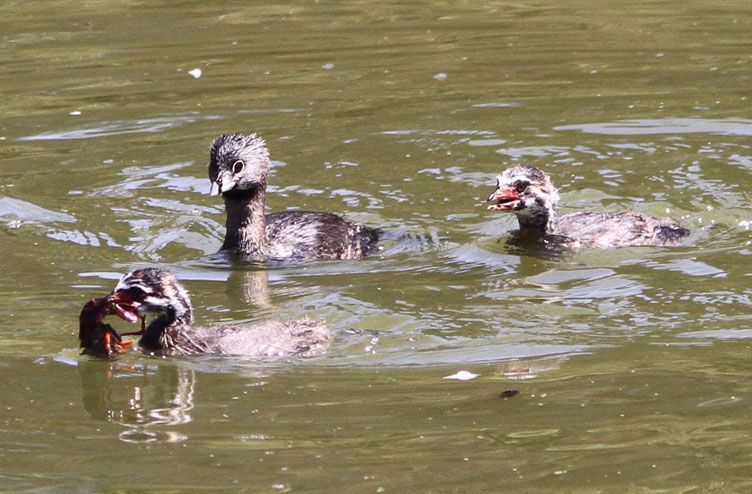 Most migratory grebes have different plumages in summer and winter, but more sedentary species, like Pied-billed Grebe
(right), wear similar plumages throughout the year. Even this
widespread North American species has not been studied systematically
(Muller & Storer 1999). They are common where I live, and they are
great little birds, enchanting for their loud cackling calls when
hidden in the reeds and for their habitat of sinking slowly under the
surface like a submarine retreating from periscope depth. They are
highly entertaining when trying to feed a set of precocial young. In
this shot (right) the adult has passed on a crawfish to one precocial
young — who is having a bit of trouble dealing with the clawed prey —
while the other youngster complains that the sibling was given the prey. Most migratory grebes have different plumages in summer and winter, but more sedentary species, like Pied-billed Grebe
(right), wear similar plumages throughout the year. Even this
widespread North American species has not been studied systematically
(Muller & Storer 1999). They are common where I live, and they are
great little birds, enchanting for their loud cackling calls when
hidden in the reeds and for their habitat of sinking slowly under the
surface like a submarine retreating from periscope depth. They are
highly entertaining when trying to feed a set of precocial young. In
this shot (right) the adult has passed on a crawfish to one precocial
young — who is having a bit of trouble dealing with the clawed prey —
while the other youngster complains that the sibling was given the prey. |
||
Two largish Podiceps grebes have wide ranges in Eurasia — Great Crested Grebe (below left) and Red-necked Grebe (below right) — but the latter is also found throughout North America, breeding at high latitudes and wintering along the coast farther south. Both are shown below in breeding plumage although the Red-necked was oiled or injured and was summering at Monterey, California, instead of migrating north to Alaska. |
||
|
||
In central North America two closely-related species of Aechmophorus grebes face these challenges. These are Western Grebe (below, upper bird) and the Clark's Grebe (below, lower bird) which behave as different species. Considered a single species "Western Grebe" for over a hundred years, studies in the late 20th Century [e.g., Ratti 1979, Nuechterlein 1981, Storer & Nuechterlein 1992] showed that the two types mated assortatively. Clark's is the one with more white in the plumage (up around the eye, on the flanks and neck) and a brighter orange bill (greenish-yellow in Western) but there remain some birds that appear intermediate (see Eckert 1995). Where I live in Monterey County, California, there is a huge reservoir (Lake San Antonio) where both species nest when water conditions are right. There can be drought years of no breeding at all, but in wet years hundreds of pairs of each type nest close to each other Apparently it is differences in mating calls and in their "dances" — when pairs dramatically run synchronously across the water elevated on their fast-paddling feet — that usually keeps them separate. The rest of the year they frequent coastal bays and estuaries and often sit side-by-side. We do see a few apparent hybrids or intergrades in these flocks. |
||
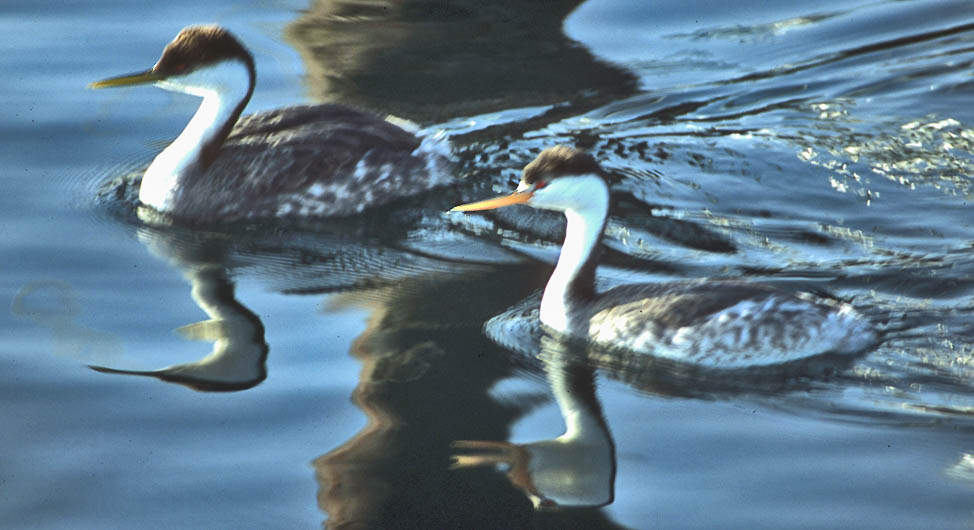 |
||
Most of the world's grebes are widespread in range, which is why I've already seen over 80% of them. However, some grebes, like Hoary-headed Grebe of Australia and New Zealand (left), are patchy and local. Two grebes occur only on single lakes or lake basins: Junin Grebe Podiceps taczanowskii on Lake Junin in the Andes of central Peru, and Titicaca Grebe Rollandia microptera of the Lake Titicaca basin in the Andes of southern Peru and western Bolivia. Both are scarce and declining. Hooded Grebe Podiceps gallardoi of southern Argentina, was not described to science until 1974. It is a beautiful small grebe of Patagonia that is rare, local, and seriously declining — it breeds on a few interior lakes. At the moment, these are the three grebes I've not seen.
|
||
| Three grebes have gone extinct in the last half-century: Alaotra Grebe Tachybaptus rufolavatus was restricted to a single lake in northern Madagascar and was last seen in 1950. Colombian Grebe Podiceps andinus of the Colombia Andes was last reported in 1997, and the large flightless Atitlan Grebe P. gigus of Lake Atitlan, Guatemala, went extinct by 1986. | ||
Photos: The molting Eared Grebe Podiceps nigricollis was in Carmel Valley, CA, USA, on 19 Apr 2019. The sequence of a diving Eared Grebe was taken in Monterey harbor, CA, USA, on 7 Apr 2017. Greg W. Lasley photographed the copulating Least Grebes Tachybaptus dominicus on their nest near Linn, Hidalgo Co., Texas, on 30 July 1995. The family of Pied-billed Grebe Podilymbus podiceps was at Laguna Grande, Seaside, CA, USA, on 6 Sep 2016. The Australasian Grebe Tachybaptus novaehollandiae was at Waro Lake, New Zealand, on 17 Nov 2009. The Great Crested Grebe Podiceps cristatus was at Xianghai Lake, China, on 12 June 2004. The Red-necked Grebe Podiceps grisegena was at Monterey, CA, USA, on 14 June 2019. The Horned Grebe Podiceps auritus was at was turning eggs on her nest at Churchill, Manitoba, Canada, in July 1988. The Western Grebe & Clark's Grebe Aechmophorus occidentalus & clarkii were adjacent at Monterey, CA, on 9 March 2003. The Hoary-headed Grebe Poliocephalus poliocephalus was Lake Seppings, West Australia, on 11 Aug 2008. Uncredited photos © Don Roberson. Credited photos © Greg W. Lasley, as credited and used with permission; all rights reserved. Bibliographic note: There is no "family book" per se, but a fine introduction to this family, with excellent photos, is in Llimona & del Hoyo (1992). That volume of Handbook of Birds of the World was before molecular evidence had re-sorted the relationships between many bird families. Literature cited:
|
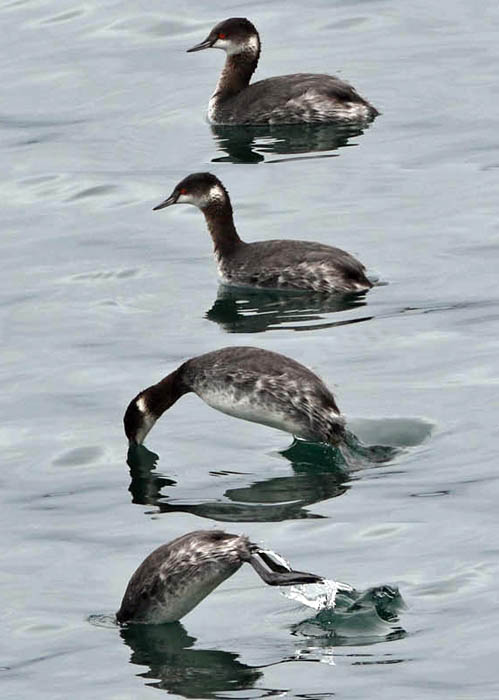 The
grebes are an ancient family going back 80 million years,
well-represented in the fossil record, and not closely related to any
other birds (Llimona & del Hoyo 1992). The highly migratory
northern hemisphere species, like Eared Grebe (above
& left), are brightly feathered in summer but become plain
dark-and-white in winter. The photo (above) shows a spring Eared Grebe
in body molt — it is molting in its orange ear-tufts and its black neck
(in much of the Old World the bird is called "Black-necked Grebe").
Grebes are very well-adapted to diving and chasing prey (often small
fish) underwater. My collage (left) shows an Eared Grebe in winter
diving from the surface of Monterey harbor; these four frames were shot
consecutively and then combined into one The legs are set well back on
the body and toes lobed.
The
grebes are an ancient family going back 80 million years,
well-represented in the fossil record, and not closely related to any
other birds (Llimona & del Hoyo 1992). The highly migratory
northern hemisphere species, like Eared Grebe (above
& left), are brightly feathered in summer but become plain
dark-and-white in winter. The photo (above) shows a spring Eared Grebe
in body molt — it is molting in its orange ear-tufts and its black neck
(in much of the Old World the bird is called "Black-necked Grebe").
Grebes are very well-adapted to diving and chasing prey (often small
fish) underwater. My collage (left) shows an Eared Grebe in winter
diving from the surface of Monterey harbor; these four frames were shot
consecutively and then combined into one The legs are set well back on
the body and toes lobed. 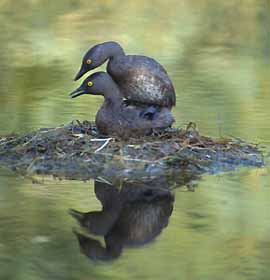
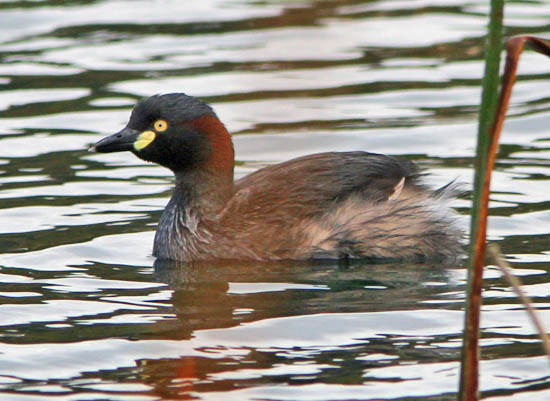 The Old World example of a small, more-or-less uniformly patterned small resident grebe is Little Grebe Tachybaptus ruficollis in Africa and Eurasia, and a similar species Australasian Grebe (left), is in Australia, New Guinea, and New Zealand. The Madagascar Grebe T. pelzelnii is also small but differently patterned.
The Old World example of a small, more-or-less uniformly patterned small resident grebe is Little Grebe Tachybaptus ruficollis in Africa and Eurasia, and a similar species Australasian Grebe (left), is in Australia, New Guinea, and New Zealand. The Madagascar Grebe T. pelzelnii is also small but differently patterned. 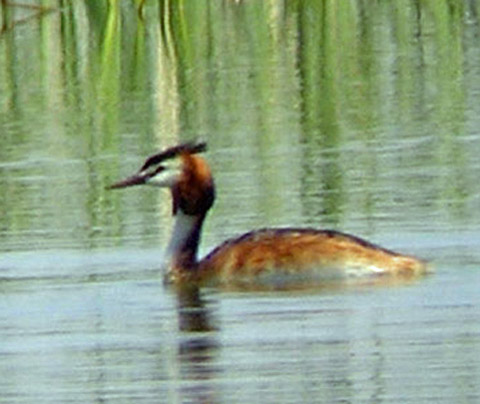

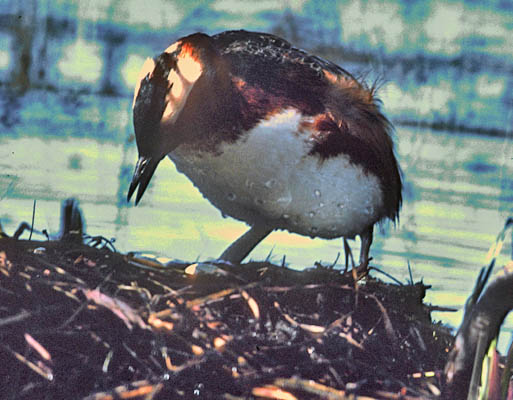 Migratory grebes, including Horned Grebe
(right) build sloppy floating nests out of vegetation. This nest has
eggs which must be turned regularly. All grebes that nest on floating
islets can be at the mercy of water levels. If water levels get too
high the eggs or chicks can be lost of flooding. If water levels drop
precipitously, eggs or young can be within the reach of mammalian
predators.
Migratory grebes, including Horned Grebe
(right) build sloppy floating nests out of vegetation. This nest has
eggs which must be turned regularly. All grebes that nest on floating
islets can be at the mercy of water levels. If water levels get too
high the eggs or chicks can be lost of flooding. If water levels drop
precipitously, eggs or young can be within the reach of mammalian
predators.